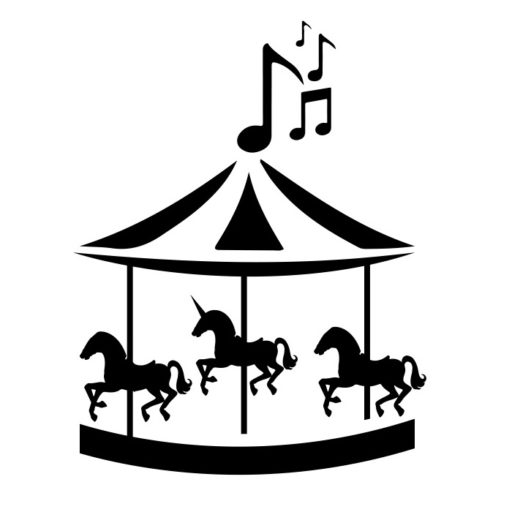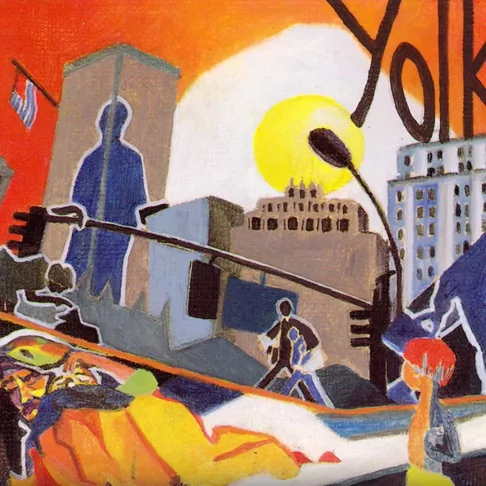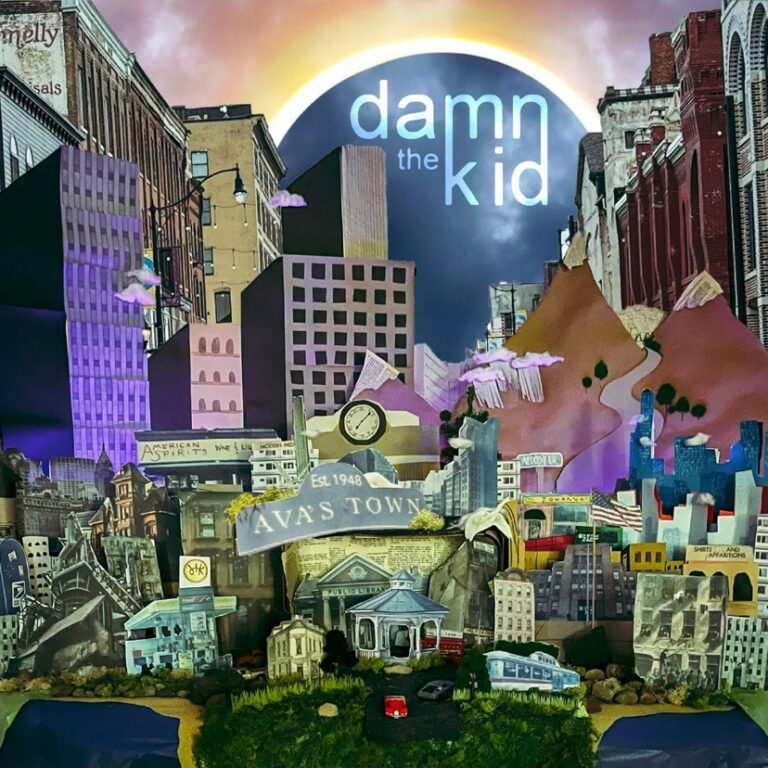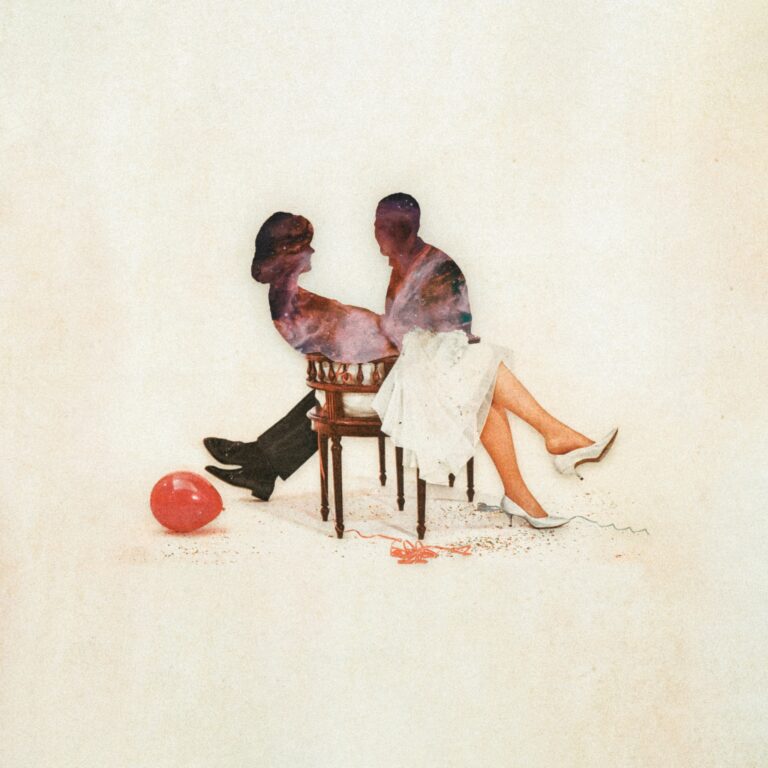It’s difficult to believe that Yolk’s self-titled debut album is now thirty years old. My recollection of hearing their music for the first time is as vivid to me as another Yolk-related memory from just three years ago: sitting in the living room with my stepdaughter Noelle, a pair of guitars between us, chatting about my past exploits in music while admiring her impressive early efforts to master the Femmes’ Blister in the Sun.
Noelle asked me that day what my first gig was like, so I started telling her about the first real, public show Stargrove ever did, back in the 1990s. But I barely got past describing the baggy, dangerously-caffeinated early teens that had assembled inside and outside of Java Joe’s before we’d stopped talking about Stargrove entirely. For me, the highlight of that performance had nothing to do with our band, and everything to do with Yolk, for reasons I’ll explain a bit later.
From there, our conversation had shifted entirely. I needed to introduce her to this band that played such a crucial role in my musical upbringing. A band that shifted my tastes and broadened my willingness to experience other genres. And soon, we had set our guitars down and were listening to Yolk’s debut album. The fact that Noelle was 14 at the time, the same age I was when I first heard those same songs, was far from lost on me.
I’ve wanted to create Parlor City Sound for a very long time. But it was that day, sitting with Noelle and chatting about the Binghamton music scene in the 90’s, that I knew this website would be made sooner rather than later. And that conversation? It needed to become this article about Yolk that you’re reading right now.
There were horns! Was this even rock? What the hell is this?
It’s early 1994. I’m barely 14 years old. It’s a school night, but insomnia has afforded me many late evenings listening to music through my headphones at hours far surpassing the average bedtime of my peers. My totally bitchin’ Aiwa sound system (IYKYK) is tuned into one of America’s last remaining free format radio stations, WHRW.
I don’t remember what song had convinced me to stay on 90.5 FM—knowing me at that age and how college radio was then, it was probably Dinosaur Jr. or Blur—but I’m glad I decided to stick around into the next song. I had no idea what I was listening to, but I knew I was madly in love with it from the opening guitar fade-in. The drums were impeccable. The bass work was ripping my brain in half. The guitar riffery would make John Frusciante blush. The vocals were excellent, and the horns? There were horns! Was this even rock? What the hell is this?
It wasn’t until the second song from this mystery band that I really processed how flawlessly all of this was working together. This band, whoever they were, had a degree of talent I couldn’t quite wrap my head around. They were melding all of these different genres together in ways I couldn’t fully process with my adolescent brain. What band is this? Do I need to call the radio station to find out? Tell me! Tell me who this is!
It was after the third song that the mystery had been solved. I had just heard the songs Green, An Ugly Truth, and The Ledge … the first three songs off of the debut album from Yolk.
To many kids my age, Yolk were indistinguishable from magic
I think I was around 12 years old when I’d first heard of Yolk, who went by the name Groove Socket back then. My older brother, Mike, had told me about this incredible band he’d seen live. And if Mike thought a band was a cool, I wanted to like them too. There was just one problem: I had never heard their music. And how could I? It’s not like I, a preteen, was going out to the Tasmanian Embassy, West Side Cheers, or the Haunt and taking in live music. Even if my parents would’ve allowed that, which they positively wouldn’t, I’d never get through the door.
It wasn’t long before I started hearing other kids talking about the band Groove Socket, and then Yolk, when walking down the halls at West Middle, and then at Binghamton High too. These kids couldn’t see them either, and mostly knew about them through their own older siblings. But it wasn’t long before knowing about Yolk put you in a certain social caste amongst those more musically-inclined kids.
To many kids my age, Yolk were indistinguishable from magic. And to have somehow seen them live at that age? That was some stratospheric echelon of awesomeness that probably earned you a set of aviators, the sort worn by those skateboarding anthropomorphic marketing creatures. And probably a sleek velvet smoking jacket, too.
But this couldn’t be the same Yolk, right? This band was so professional. Their levels of talent were astronomical. This was a proper studio recording, too, with the sort of quality you’d expect from Electric Lady or Sunset Sound. They were on the radio and had a CD out. It somehow didn’t seem real that these guys had 607 area codes.
Yolk may as well have been dragons
At the risk of pratfalling toward goofy ageism, it’s worth pointing out that Noelle is a Gen-Z kid, and that means there’s a certain element of this Yolk story she couldn’t quite appreciate in all its glory. She’s grown up in an era of media innovations far removed from the Walkmans and MTV of yesteryear. And no, I don’t mean this in a “my generation wrote in cursive and drank from a garden hose” way. Sure, our generation could spearfish our favorite songs off the radio with a cassette deck. But Noelle is making hyper-advanced fan edits of Paramore videos for TikTok using nothing but her phone, and can navigate a modern DAW. My generation struggled to program a VCR. We are not the same.
Having said that, Noelle has grown up in an age where everything is online. And as impossibly talented as Yolk was, I don’t think they’d have established that same degree of Zeppelin-esque mystique if they were making music today.
We didn’t have YouTube or Spotify back in those days of walking uphill both ways in the snow. If you wanted to hear a band, it meant you had to physically travel to a music venue. That was difficult to do if you were younger than 21, and nearly impossible if you were under 18. That meant Yolk was off-limits to us. And to know there’s this amazing, cool thing that society was keeping away from you made you want it even more. They were inaccessible, admired by older kids, and reportedly amazing to see. Yolk may as well have been dragons.
A sense of local pride kids never really had or have, then or now, here or anywhere
It was around this point in the story that Noelle started questioning where I was going with all of this. She just wanted to know what my first gig was like, and suddenly I’m fifty miles from the nearest rail, carrying on about how awesome some other band was. But all of that context mattered in big ways … because my band, Stargrove, never would’ve existed had it not been for Yolk.
Even if you’d never heard their music, Yolk instilled in people a sense of local pride kids never really had or have, then or now, here or anywhere. Kids don’t care if IBM or Dick’s Sporting Goods or Valvoline were founded in Binghamton. None of that is cool. Some innovative, cutting edge rock band? That’s cool. That’s the sort of thing you want Binghamton to be on the map for. Not computers, or carousels, or the Twilight Zone, or some artsy-fartsy film-noir movie starring Bill Pullman that you were way too young to wrap your head around.
Watching Yolk waltz into local mythology made me want to take music more seriously. It made me want to start a band. I wanted to create something people adored with even a fraction of that love. I had never heard a single Groove Socket or Yolk song, but that band had inspired me to make music all the same. So I started Stargrove with my best friend and lifelong bandmate Colin as a direct result of hearing all these people elevating this local Binghamton band with cult like flair.
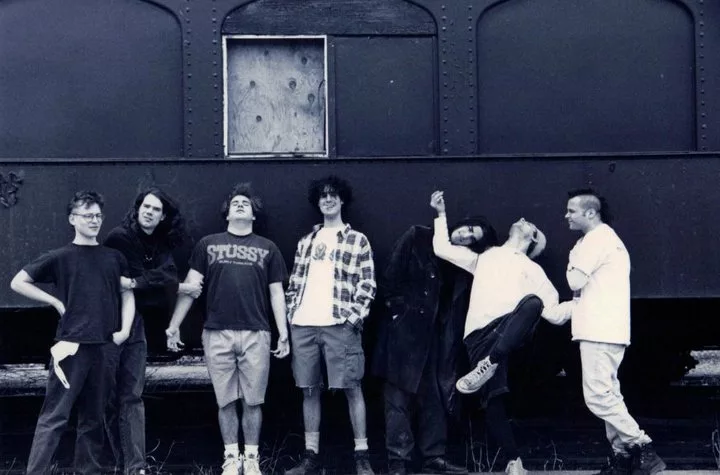
You really can’t sum them up in any one genre, unless you call that genre ‘Yolk’
It wasn’t until I heard Yolk’s music that I really came to appreciate why so many people talked about them the way they did. Yolk wasn’t just another early 90s grunge band stomping fuzz pedals and screaming for the sake of screaming. And don’t get me wrong, I love that too. But Yolk offered this unlikely marriage of genres that should come together as gleefully as Montagues and Capulets. How they made it all work together is a mystery to me even to this day.
On paper, the concept of throwing a hundred genres into a blender simply shouldn’t work. Grunge, jazz, metal, funk, blues, hip hop, even trace amounts of folk … that’s a musical smoothie that should result in life-threatening brain freeze. And yet somehow, Yolk managed to whip all of that into something I can truly only describe as one of the most unique sounds I’ve personally ever heard. You really can’t sum them up in any one genre, unless you call that genre “Yolk”. Labeling them as a “jam band” feels like an injustice.
Couple that original style with a stage show overloaded with enough raw energy to hurl a moonshot, and it’s no wonder this band would be sharing stages with world-famous acts like Sonic Youth, Fishbone, Ween, and Wyclef Jean, as well as fellow legendary Upstate NY acts like the Ominous Seapods and moe.
Hearing Yolk for the first time, it quickly became evident that simply starting a band wasn’t enough. We had to be in a good band. Stargrove wasn’t going to get by with angry punk songs about how Mrs. Zdeb dished out too much English homework. We needed depth, and some fraction of talent wouldn’t hurt either.
Talent was something Yolk had in gratuitous abundance
Yolk’s recipe for their genre stew balanced out those ingredients surprisingly well, but it takes more than a Pyrex and a dream to make something like that work. Music isn’t a cheesy romantic Hallmark movie. Opposites don’t usually attract in this space. And yet Yolk’s music manages to ebb and flow and create harmony where you’d expect resistance. That’s something you can’t really do without levels of talent and musical competence typically reserved for battle-hardened session musicians with decades of experience under their belts. And talent was something Yolk had in gratuitous abundance.
I was just getting into playing drums around then, so Matt Murphy was always particularly mind-blowing to me. His drums were powerful and precise, claiming ownership over the rhythm with surgical swing and impeccable fills. And Jim Lomonaco’s bass playing always seemed to defy gravity, with this sound you can’t rightfully describe without mentioning the likes of Jaco Pastorius, Bootsy Collins, and a bit of Les Claypool.
Guitarists Pete Carvelas and Dave Fitzhugh managed to work symbiotically, despite a diametric opposition in tonality and style. Sweet, dutiful jazz licks sweep in from one corner while chunky, grungy, metallic riffs punch from the other. Neither style oversteps the other; they dance together, pouring on huge helpings of substance. Then you had Jeff Pettit and Adam Ash using their horns to exhibit a master class in musical hypnosis akin to what you’d expect from some great jazz work, driving this impregnable wall of sound.
Given all of this superhuman instrumentalism, it’s all the more impressive that vocalist Jim McCabe is never once outshined by his instrument-clad brethren. He delivers sturdy, deep fluidity to the score of lyrics motivated by the human condition, with political messaging that somehow still eerily resonates to this day.
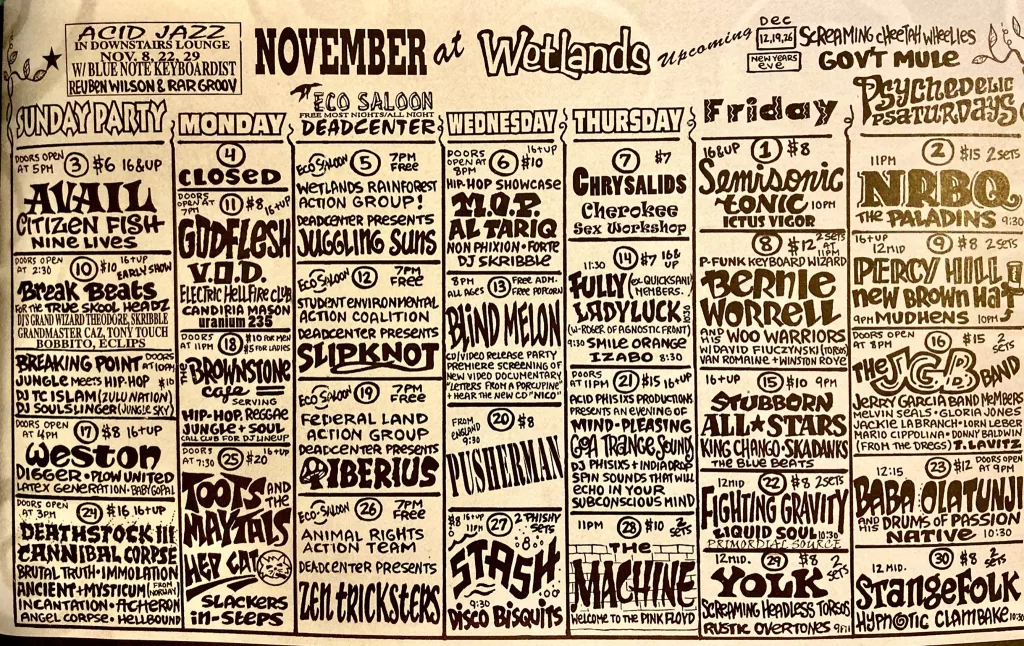
Yolk and Jeff DaBella didn’t have to drive into Manhattan to make this album
None of that musical virtuosity was lost on my young guitar protege, a special kid who truly appreciates the talent that goes into each and every instrument. But at some point I found myself gushing about the sound quality of this recording, so again, Noelle needed a bit more context.
In my lifetime, home recording has evolved immeasurably. Stargrove’s earliest recordings were done on a Portastudio we borrowed from another band (Shiver U.K., probably), using those cheaper Shure mics that looked like 57’s and 58’s but entirely weren’t. We needed to keep a pencil handy to manually wind the cassettes if they jammed up. And even when we did eventually record in a professional studio, the audio quality was nowhere near what Yolk’s debut album had, let alone the two Yolk albums that followed it.
At first, I assumed Yolk must’ve traveled into New York City to produce this record. But nope … this was tracked, mixed, and mastered in Vestal at Audio Arts, owned then by another Binghamton music scene legend, producer Jeff DaBella. Yolk and DaBella had created this beautiful sounding album, and they didn’t have to drive into Manhattan to do it.
This was yet another thing that lent itself to Yolk’s superstar aura. They had a professional CD that you could walk into Music City and buy. Kids today may not be impressed by that. You can just go on Spotify and stream any band or artist you like, including Yolk. But in 1993, a local band with a real tape or CD you could buy in a store? That was yet another indicator that they were going places.
Two members of Yolk—the Yolk—had just seen us playing!
At this point Noelle and I had been talking about music for ages, and I still hadn’t answered the question she asked to get this whole conversation rolling. I did a decent job of explaining how Yolk inspired us to want to start our own band, sure. That had been covered exhaustively. So surely, she was done hearing about Yolk at that point, right?
Well … no.
Java Joe’s was this trendy coffee joint where ultra-hip Binghamton kids would guzzle bottomless cups of coffee while drawing, hacking, skating, and blasting out Sublime on their acoustic guitars. That’s where Stargrove did our first show, in front of a crowd that was a lot bigger than any of us were anticipating. And it seemed a lot of people enjoyed it, too … apart from one cranky newspaper writer in attendance, who referred to us as “a bunch of noise” within my earshot minutes after we finished our set.
That definitely stung a bit. But I barely had time to process that before I encountered the biggest surprise of the night: two members of Yolk—the Yolk—had just seen us playing. And they walked right up to me, saying they thought we sounded great.
It didn’t feel like real life.
I’ve met a handful of celebrities in my day, but only on two occasions have I ever really felt starstruck. Last year, my wife and I met Australian songwriting legend Gareth Liddiard outside of the famed Horseshoe Tavern in Toronto. That was huge. But these two Yolk guys complimenting me when I was maybe 15 years old or thereabouts? That was on par with the asteroid that took down the dinosaurs. Including that belittling dickosaurus from the Binghamton Press & Sun.
All these years later, Yolk is still larger than life
Yolk was a band entirely comprised of mortal humans. But all of what Noelle and I had been discussing—their immeasurable talent, the numerous qualities of their debut album, that inaccessibility that added to their height by multitudes—all of that meant Yolk were larger than life. And to Binghamton kids like me, their celebrity status was akin to those glossy porcelain figures propped up on television and in magazines.
Having someone from Yolk confirm my music and encourage me to make more? It may as well have been Lee Ranaldo, or a celebrity without a direct Binghamton link like J Mascis or Kim Deal. They all hailed from that same elevation as far as I was concerned.
You’d think all of that celebrity flutter would’ve evaporated by now, right? I’ve met all of these guys through the years, getting to know some better than others. I couldn’t have written this article without Jeff Pettit’s help, given my memory is about as reliable as an ’86 Yugo. Heck, my band Piso Mojado even worked out of Yolk’s old NYPenn Trade Center studio back in the very early aughts (2000? 2001? I can’t remember … curse you, Yugo!).
And yet I still occasionally experience that giddiness, as corny as some might say it is, when someone from Yolk is in the room. It could be something as silly as Adam Ash and I joking about some political thing, or Jeff Pettit putting a like on my Spotify Wrapped, or that time Jim Lomonaco visited with Piso Mojado at the studio and seemed to genuinely dig our music. I still sometimes catch myself feeling lucky to share air with these guys. Even today, all these years later, Yolk is still somehow larger than life.
This album helped shape the music of a lot of Binghamton’s musicians
That conversation was a history lesson Noelle never once signed up for. I surely could have told her about that Stargrove show without first exposing her to 90’s Binghamton youth culture and rambling for an hour about what some other band meant to me and a lot of other kids around my age. But Yolk is woven into the Stargrove story in ways that simply can’t be untangled. You’re better off trying to unravel that nightmare rat king ball of Christmas lights in your attic.
If Yolk didn’t exist, we probably wouldn’t have been inspired to start a band. And if those two guys from Yolk hadn’t attended that first show and said what they’d said, I may not have found the courage to get on stage again.
This article could’ve been written in 600 words or less. I could’ve just penned some quaint retrospective on Yolk’s debut album, celebrating its 30th anniversary with a tour of its tracks and maybe a nice little note on the band’s mythological status in the Binghamton music scene. But this album was too important for something so brief. It really did shape the music of a lot of Binghamton’s musicians, myself included. It inspired me to break out of my shell, to listen to new things and try incorporating different genres into my music. And having chatted with these guys through the years, I honestly don’t believe they really understood what their music meant to some of us.
Celebrating the talent and mysticism of Yolk—an intrinsic valve in the heart of local music history
To me, this 30th anniversary of Yolk’s self-titled debut album is about more than the release of a CD. To some of us, it marks a watershed moment for the Binghamton music scene that fueled up many a creative kiln. And it’s difficult to really talk about that Parlor City Sound our website is named after without also celebrating the talent and mysticism of Yolk, whose music forms an intrinsic valve in the heart of local music history for a significant number of people.
When I sit down and listen to this debut Yolk album today, three decades since it first came out, I’m not just listening to their songs. I’m thinking back on those bands we’d gigged with and spent time around, and how those other musicians would talk about Yolk, and reference their songs with the expectation that you knew what they meant, because how could you not?
And I think about Noelle, too. This kid has so much talent and potential. Guitar, ukulele, and keys come so natural to her, and she wants to learn drums and bass as well. Her music tastes are evolving so rapidly now at 17, shedding that plastic top 40 sheen to the quake of distortion. I want her to know about Yolk and explore their music as I had at that age, hoping her own horizons will be broadened by their music the way mine were. I hope someday I’ll join my four-year old daughter Kamaria on this same journey, too. And no, I won’t just read her this article. We’ll have a similar discussion to this one, guitars in our laps, and Yolk’s debut album filling that room with music, light, and love. And surely I’ll think to myself so this is heaven.
